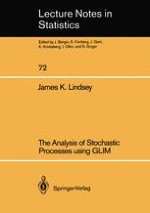1992 | OriginalPaper | Buchkapitel
Time Series: The Frequency Domain
verfasst von : James K. Lindsey
Erschienen in: The Analysis of Stochastic Processes using GLIM
Verlag: Springer New York
Enthalten in: Professional Book Archive
Aktivieren Sie unsere intelligente Suche, um passende Fachinhalte oder Patente zu finden.
Wählen Sie Textabschnitte aus um mit Künstlicher Intelligenz passenden Patente zu finden. powered by
Markieren Sie Textabschnitte, um KI-gestützt weitere passende Inhalte zu finden. powered by
In the previous chapter, we studied how a series of observations evolves over time. Another approach is to study how the series varies in frequency: the periods of cyclic phenomena. To do this, we require an estimate of the spectral density function which is a complementary function to that expressed in the correlogram. Spectral analysis involves decomposing a function into a sum of sines and cosines, an adaptation of Fourier analysis to stochastic variables. Suppose that our time series can be represented by an unknown function of time, E(yt = g(t;ω). Then we decompose this function:7.1$$ g(t;\omega ){{ = }_{{\frac{{{{\user2{a}}_{o}}}}{2}}}} + \sum\limits_{{\user2{r} = 1}}^{\user2{M}} {({{\user2{a}}_{\user2{r}}}\cos {{\user2{\omega }}_{\user2{r}}}\user2{t}} + {{\user2{b}}_{\user2{r}}}\sin {{\user2{\omega }}_{\user2{r}}}\user2{t)} $$7.2$$ _{{\frac{{{{\user2{a}}_{o}}}}{2}}} + \sum\limits_{{\user2{r} = 1}}^{\user2{M}} {{{\user2{R}}_{\user2{r}}}} \cos ({{\user2{\omega }}_{\user2{r}}}\user2{t + |}{{\phi }_{\user2{r}}}) $$is the amplitude of the rth harmonic of the series,ωr = 2π/Pr = 2πr/N is the frequency of the rth cycle, where pr is its period or length, φr = tan-1 (-br/ar) is the phase, and r (1 ≤ r ≤ M = [N/2]) are the fundamental or Fourier frequencies. Then, 7.3$$ \user2{I(}{{\omega }_{r}}) = NR_{1}^{2}/4\pi $$ is known as the periodogram, and is plotted against ωr. In this way, the total area under the periodogram equals the variance of the time series. (Rr2/2 plotted against r would give the same result.)
